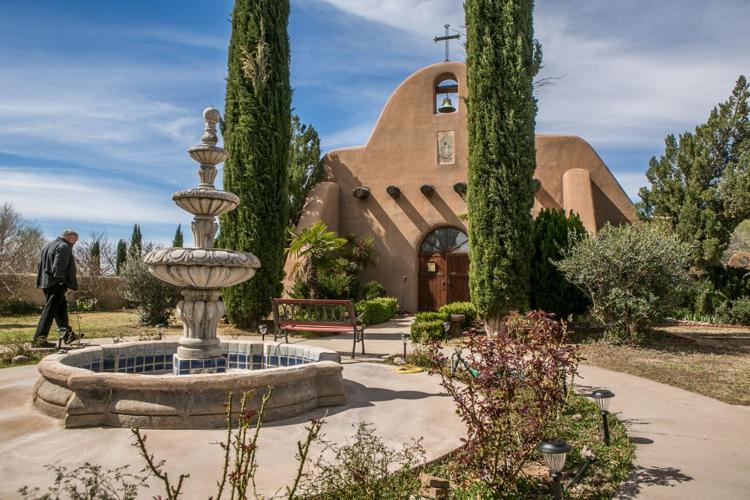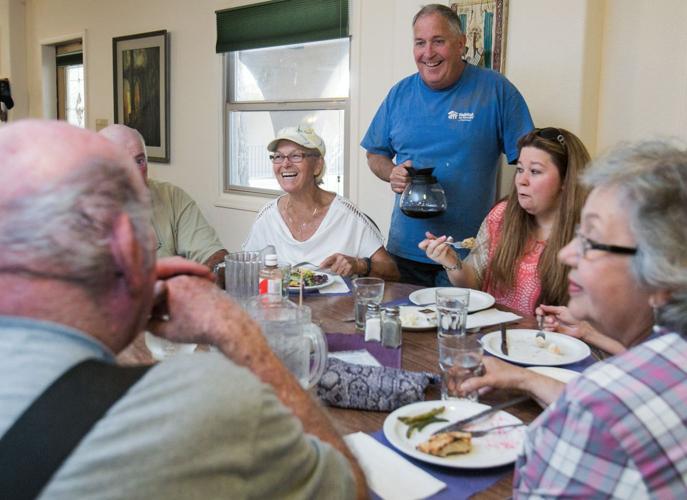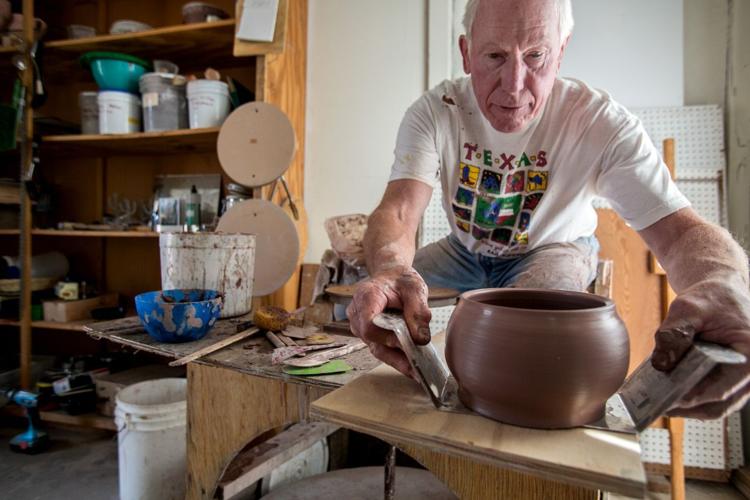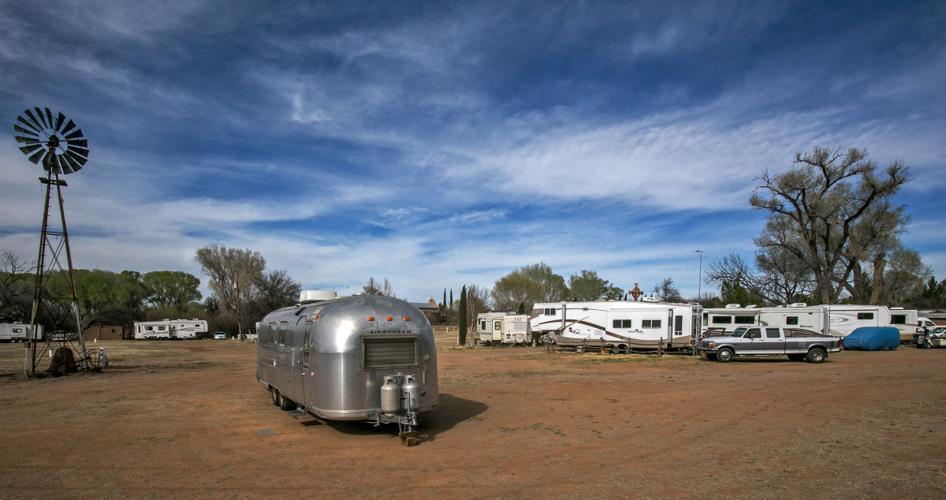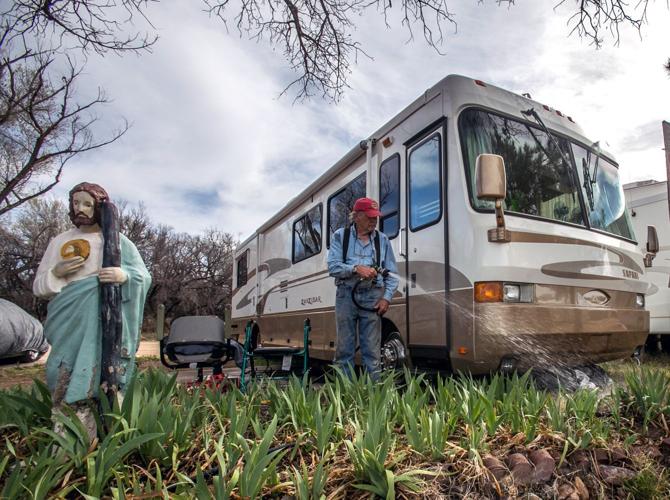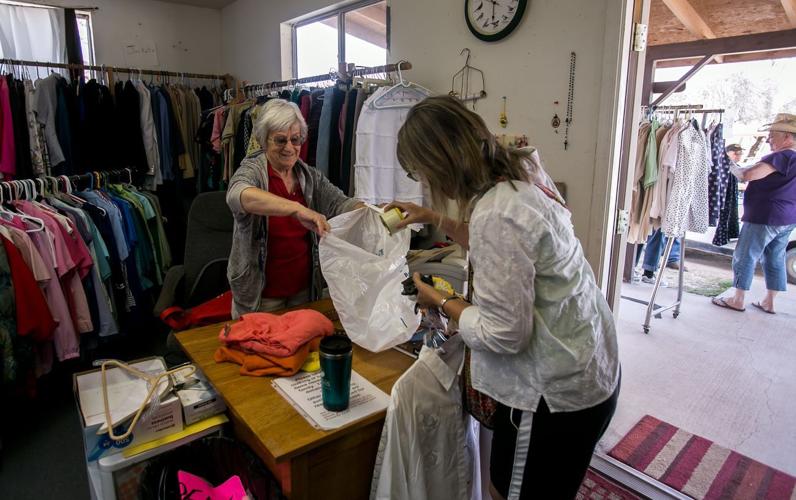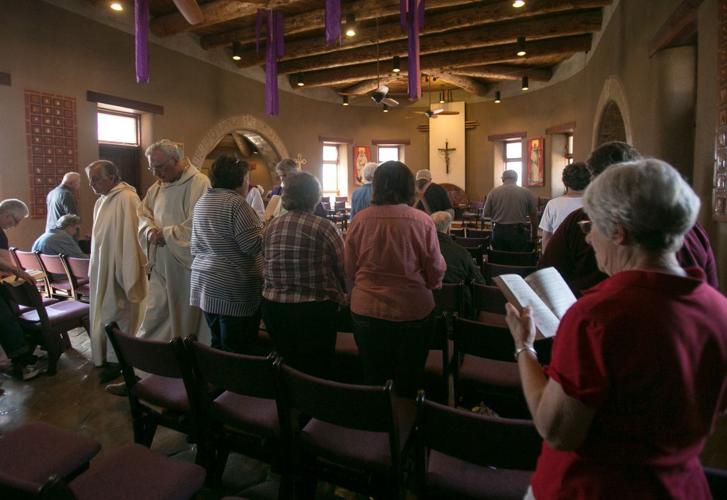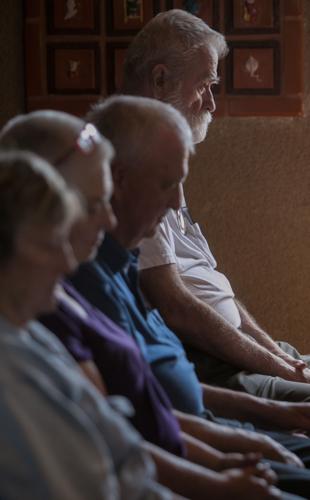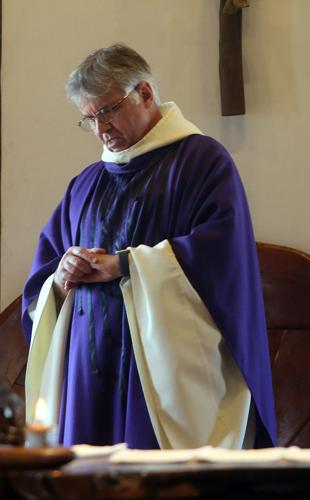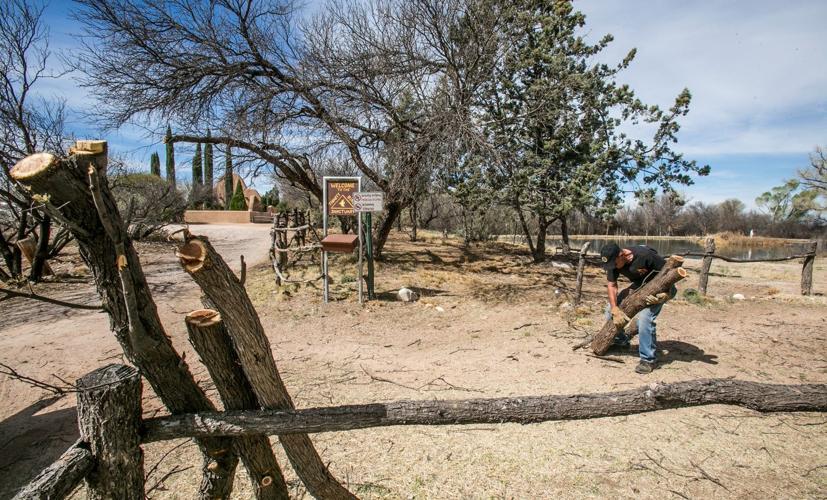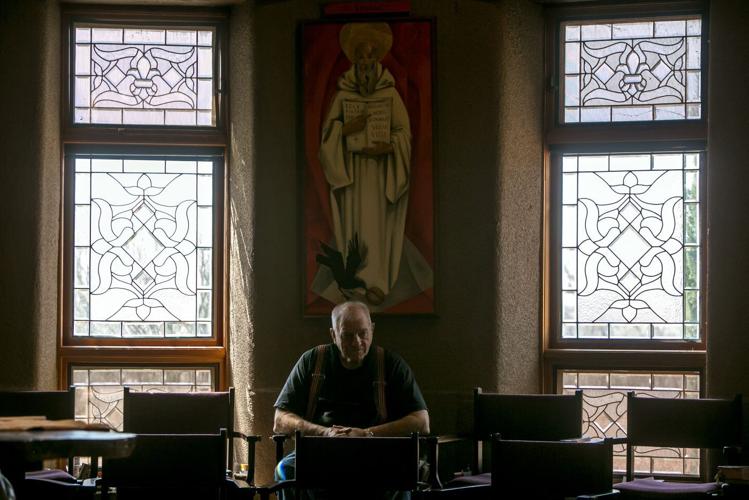With the moon still visible in the early morning sky, the clang of Holy Trinity Monastery’s church bell summons the flock to start the day.
The faithful shuffle in for 7 a.m prayer and as the sun rises, peacocks roosting in the neighboring meditation garden leave the trees in search of their daily bread.
Thelma Meyer arrives at the church after a short walk from the Olivetan Benedictine monastery’s RV park where she lives during the winter months. Inside the chapel, eyes are closed and heads are bowed. No one speaks. Chairs creak.
Sunlight fills the room as singing and Scripture readings replace the silence.
A new day has arrived at Holy Trinity Monastery.
And there is work to do.
“We pay to work here”
Monte Cassino RV Park is mostly quiet after morning prayers when Meyer stops by what monastery residents call the nut and crack houses.
Here, they crack and clean the pecans harvested from about 100 trees at the entrance of the monastery. Meyer manages the harvest, enlisting help from the RVers who come and go.
At the end of February, many of the 16 full RV hookups are still in use, occupied by snowbirds from around the country. Many — like Meyer — have been coming for years. Affectionately, they are known as the holy hoboes.
They pay to work here, says Meyer, who started wintering at the monastery 26 years ago with her husband, Vern, who died in 2012.
Still, Meyer, 83, returns, trading Granger, Iowa winters for hard work, friendly neighbors and religious life.
When the Rev. Louis B. Hasenfuss arrived in St. David in 1974 to start the monastery, he imagined a community similar to the early church as depicted in the biblical book of Acts — all kinds of people devoted to God and working together.
For a while, families with children lived on the grounds, says the Rev. Henri Capdeville, the current monastery prior and successor to Hasenfuss. Capdeville came to the monastery shortly after it opened with more than a dozen other 20-somethings.
Now, many of the monastery’s residents are 60 and older.
“Most people think we’re crazy that we pay to work here, because we work so hard and there is so much to do,” says Meyer, who calls herself the RV host. She estimates that she and her husband were some of the first snowbirds to settle in at the RV park not long after it opened.
The monastery owes much to the Meyer family. They built the outdoor Stations of the Cross, and Meyer’s husband also built the bridge in the meditation garden and oversaw the construction of a building the RV residents use as a gathering place. Her son paid $50,000 to fund the project, and the monastery matched it.
Meyer’s husband, like so many others who find the monastery, discovered a new life in retirement.
“A lot of men aren’t golfers and want something to do, and that’s why they come back here,” Meyer says. “There’s always something to do.”
And so the holy hoboes join the monastery’s full-time residents to maintain the property, an estimated 150 acres, with multiple ponds, a bird sanctuary along the San Pedro River, a library and guesthouses, among other features.
When the snowbirds leave come spring, they are missed.
“The snowbirds, or whatever you want to call them, when they come, oh, they work,” says Mary Ellen McCarthy, an 85-year-old who has made her permanent home at the monastery for 28 years. “One guy even cleaned the rain gutters for me.”
Daily bread
Normally, the religious community at the monastery crunches breakfast cereal and sips coffee in silence.
But not today.
Sherry Wasko has business to conduct.
Wasko manages the associates — a handful of volunteers who sample the monastic routine of prayer and work for three to six months.
Three monks, including Capdeville, one sister and about 10 laypeople call the monastery home all year, says Tom McGuire, the editor of the monastery’s newsletter. The number of residents can double in the winter, as snowbirds arrive.
Many are oblates, or laypeople who have devoted themselves to following the Rule of St. Benedict.
While they eat, Wasko, an oblate and full-time resident, talks about preparing the monastery for a group that will stay the weekend. They need to assign kitchen duties and check that the guesthouses are clean.
After breakfast, someone feeds the peacocks. The birds peck at each other for nibbles of bread. Two flocks — about 22 birds — now wander the monastery grounds. One flock recently arrived from Reid Park Zoo.
The peacocks attract visitors, says Jan Krieski, an oblate and the monastery’s guest master.
Outsiders keep the monastery afloat. From making purchases in the thrift store and book shop to spending a night or two on property to making a trip for the annual festival, visitors are a major source of income for the community.
Homeowners’ associations, yoga classes, Alcoholics Anonymous circles, religious groups and individuals pay to use the idyllic grounds for retreats and meetings.
“We have to be self-sufficient,” Capdeville says. “We have a bakery. We have pecans. We have the bookstore. And the retreats, the retreats are a big thing. ... The Lord provides. He gives us his daily bread.”
“What God wants for me”
After breakfast, Michael Emery treks to the thrift shop.
He discovered the monastery days ago, but already, its residents joke with him. They pass by the thrift store, often empty, and call out, teasing Emery about how busy he must be.
In another life, Emery worked in retail, and so he uses those skills to size and label stacks of men’s pants in the store.
This year, Emery moved to Arizona from California for a more affordable retirement. A dog groomer, he thought he would relocate his business to Phoenix.
But then he heard about the monastery.
An associate now, Emery, 70, is staying in the cloister with the monks.
The time to himself is an adjustment, especially as the snowbirds fly home for summer. He reads, plays his guitar and works — he has groomed several dogs during his stay.
In retirement, he may become a monk.
“I needed to be alone to figure out who I was and what God wants for me,” he says. “That has been my journey to here, and I have been looking for a place to do that, so here I am.”
“Not retired from life”
After the noon Mass, Bill Belkengren, 71, and others sit down for a community meal.
As a thanks for their hard work, the monastery invites Belkengren and other RVers to eat the midday meal free.
Belkengren estimates that about half of the RV residents participate in religious life. The rest just enjoy the property.
Last year, the Minnesota native discovered more than the monastery — he also discovered a kiln and kick wheel on the grounds.
A potter for 12 years now, Belkengren has donated at least 150 pieces to the bookstore for sale, he says.
This is only his second year at the monastery, but Belkengren plans on returning for years to come.
“Most of the people are retired, but they are retired from jobs and are not retired from life,” he says. “Some people sit back and take life easy, but these people are workers and volunteer for everything.”
Evening prayers
In the quiet work-filled hours after lunch, a group of RVers gather for “social hour” — a more monastery-friendly name for happy hour.
They chat about the day — cleaning the pecans, raking a garden and trying to figure out how to get more channels on the TV.
In an hour, several will filter out for 5 p.m. vespers, the prayer service that precedes an often silent dinner.
There, light pours through the chapel’s westward windows as the sun begins to set. At dusk, the peacocks will line up to make their way back into the trees, where they will perch for the night.
McGuire, an oblate and RV resident who manages the monastery’s communications, sits around the altar with his wife, Florence McGuire.
For the McGuires, the religious schedule ends at this prayer service. They will call it a day instead of attending the 8 p.m. compline service that follows.
Here, Tom McGuire, 76, finds the religious life he has always craved — he was an ordained priest for several years before marrying his wife, who once wanted to be a nun, he says.
He doesn’t deny the challenges — the routine can drag and close quarters make for moments of irritation. But for six months out of the year, this is where he belongs, in this rhythmic schedule of work and prayer.
“If you’re really faithful to it and you stay awake in it, then something happens to your soul and it brings a new kind of life,” he says. “That’s what monastic life is all about. It’s related to love of God and love of others.”


